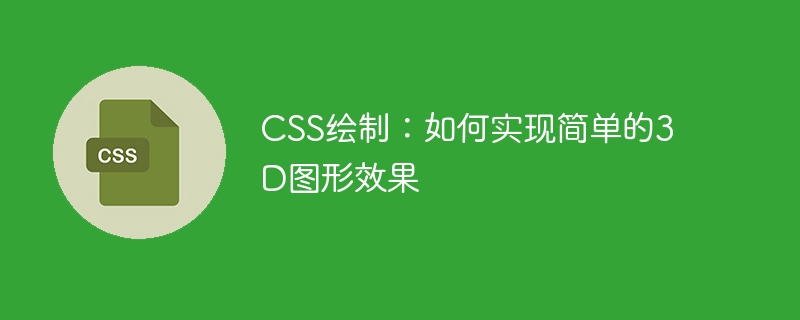

CSS Drawing: How to Achieve Simple 3D Graphic Effects
In modern web design, to add some dynamics and three-dimensionality to the page, 3D graphics are often needed. Effect. Although in the past, achieving 3D effects may have required the use of JavaScript or a professional 3D engine, CSS is now powerful enough to achieve some simple 3D graphics effects. This article will introduce how to use CSS to draw simple 3D graphics and provide specific code examples.
To draw a simple cube, we can use the transform property of CSS. First, we need an element with six sides. We can use a div element and set its width and height to the same value. Then, use the CSS transform property to rotate, scale, and move the element to achieve a 3D effect.
The following is a simple CSS sample code for a cube:
<style>
.cube {
width: 200px;
height: 200px;
position: relative;
transform-style: preserve-3d;
transform: rotateX(45deg) rotateY(45deg);
}
.face {
position: absolute;
width: 200px;
height: 200px;
opacity: 0.8;
}
.front {
background-color: red;
transform: translateZ(100px);
}
.back {
background-color: green;
transform: translateZ(-100px) rotateY(180deg);
}
.top {
background-color: blue;
transform: translateY(-100px) rotateX(90deg);
}
.bottom {
background-color: yellow;
transform: translateY(100px) rotateX(-90deg);
}
.left {
background-color: orange;
transform: translateX(-100px) rotateY(-90deg);
}
.right {
background-color: purple;
transform: translateX(100px) rotateY(90deg);
}
</style>
<div class="cube">
<div class="face front"></div>
<div class="face back"></div>
<div class="face top"></div>
<div class="face bottom"></div>
<div class="face left"></div>
<div class="face right"></div>
</div>In the above code, we define an element with class cube as the container of the cube, and use the CSS transform attribute to set its rotation angle. At the same time, an element with class face is also defined as each face of the cube, and a different background color is set for each face.
To draw a simple cylinder, you can use CSS pseudo-elements and gradients. First, we need a container with a circular bottom, and create two pseudo-elements in the container, one representing the sides and one representing the top. Then, use the CSS transform property to rotate and move the container to achieve a 3D effect.
The following is a simple CSS sample code for a cylinder:
<style>
.cylinder {
position: relative;
width: 200px;
height: 300px;
transform-style: preserve-3d;
transform: rotateX(60deg) rotateY(30deg);
}
.cylinder::before,
.cylinder::after {
content: '';
position: absolute;
width: 200px;
height: 200px;
background: linear-gradient(to bottom, #ff5f5f, #ff2929);
border-radius: 50%;
opacity: 0.8;
}
.cylinder::before {
transform: translateZ(-100px);
top: 50px;
}
.cylinder::after {
transform: translateZ(100px);
bottom: 50px;
}
</style>
<div class="cylinder"></div>In the above code, we define an element with class cylinder as the container of the cylinder, and use CSS transform property to set its rotation angle. By using the ::before and ::after pseudo-elements, we create the sides and top of the cylinder respectively, and use the linear-gradient property of CSS to set the background color of the gradient.
Summary
By using the transform property of CSS, we can easily achieve some simple 3D graphic effects, such as cubes and cylinders. These effects not only add three-dimensionality to the page, but also enhance the user experience. I hope the code examples provided in this article are helpful to you. If you have any questions, please feel free to leave a message.
The above is the detailed content of CSS drawing: how to achieve simple 3D graphics effects. For more information, please follow other related articles on the PHP Chinese website!
 Main contents of database conceptual design
Main contents of database conceptual design
 The core technologies of the big data analysis system include
The core technologies of the big data analysis system include
 What exactly is fil coin?
What exactly is fil coin?
 Introduction to the main work content of front-end engineers
Introduction to the main work content of front-end engineers
 Characteristics of two's complement arithmetic
Characteristics of two's complement arithmetic
 Win10 does not support the disk layout solution of Uefi firmware
Win10 does not support the disk layout solution of Uefi firmware
 OuYi exchange usdt price
OuYi exchange usdt price
 How to refresh bios
How to refresh bios




